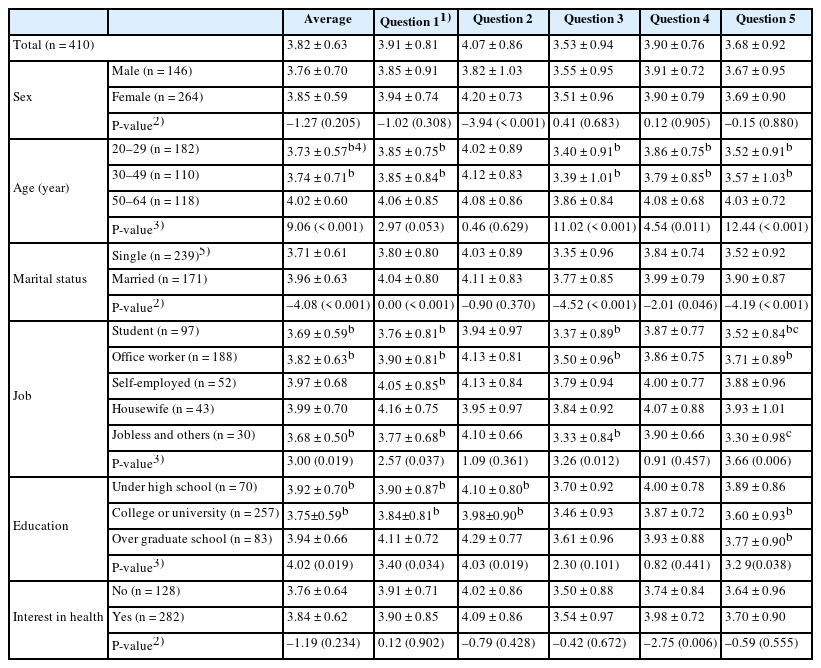Search
- Page Path
- HOME > Search
Research Articles
- [Korean]
- Adult consumers’ perception of plant-based meat substitutes and related factors in Korea: a cross-sectional study
- Yun-A Lee, Mi-Kyeong Choi
- Korean J Community Nutr 2025;30(3):237-248. Published online June 30, 2025
- DOI: https://doi.org/10.5720/kjcn.2025.00115

-
 Abstract
Abstract
 PDF
PDF PubReader
PubReader ePub
ePub - Objectives
We aimed to examine differences in experience, consumption, and perception of plant-based meat substitutes according to consumer characteristics, and to identify associated factors.
Methods
In this cross-sectional study, 410 adult consumers were surveyed regarding their eating habits, experience with and consumption of plant-based meat substitutes, and their intentions and perceptions of these products. Statistical analyses were conducted.
Results
Approximately 84% of participants had heard of plant-based meat substitutes, most commonly through mass media and social media. Overall, 65.12% reported having consumed plant-based substitutes, with higher consumption observed among older and more health-conscious individuals. The most common reason for consumption was curiosity about new foods (36.33%), whereas the primary reason for non-consumption was lack of opportunity (61.54%). Additionally, 77.32% of respondents indicated willingness to try plant-based substitutes, with taste identified as the most influential factor in purchasing decisions. Perception of plant-based meat substitutes was rated 3.82 out of 5, with significantly higher awareness among individuals aged 50–64, married individuals, housewives, graduate students or graduates, and those with irregular meal times or infrequent dining out.
Conclusion
Older, married, more educated, and health-conscious individuals who dine out less frequently tend to have higher perception scores for plant-based meat substitutes, along with greater experience and stronger future use intention.
- 374 View
- 26 Download

- [English]
- Comparison of Nutrient Intake between Hypercholesterolemic and Normal groups based on the 6th Korea National Health and Nutrition Examination Survey
- Hyun-A Lee, Hyung-Sook Kim
- Korean J Community Nutr 2020;25(5):396-405. Published online October 31, 2020
- DOI: https://doi.org/10.5720/kjcn.2020.25.5.396
-
 Abstract
Abstract
 PDF
PDF - Objectives
This study was conducted to compare the nutrient intake of normal healthy adults with those having hypercholesterolemia. Methods We analyzed data from the 6th Korea National Health and Nutrition Examination Survey (KNHANES VI). A total of 12,636 adults (5,223 males and 7,413 females) aged 19 or older were included in the study. Results Males with hypercholesterolemia were older and had a higher waist circumference, body mass index, fasting blood sugar levels (FBS) and serum triglyceride (TG) concentrations compared to the normal group. Females with hypercholesterolemia were older and had higher FBS levels and serum TG concentrations compared to the normal group. While comparing nutrient intake by the 24-hour recall method, the male normal group showed a higher intake of fat, saturated fatty acid (SFA), monounsaturated fatty acid (MUFA), vitamin A and thiamin compared to the hypercholesterolemic group. However, the male normal group had a lower intake of iron and vitamin C compared to the hypercholesterolemic group. The female normal group had a higher intake of energy, protein, fat, SFA, MUFA, polyunsaturated fatty acids, cholesterol, riboflavin, and niacin compared to the hypercholesterolemic group, but had a lower intake of iron compared to the hypercholesterolemic group. A comparison of nutrient intake by food frequency questionnaire (FFQ) showed the following: There was no significant difference in nutrient intake between the normal men and women and those with hypercholesterolemia. After adjustment for confounding factors, nutrient intake by FFQ of the male normal group showed higher levels of n-3 fatty acid and vitamin C compared to the group with hypercholesterolemia. However, there was no significant difference in nutrient intake between the two groups of women. Conclusions The average intake of n-3 fatty acids and vitamin C of the male group with hypercholesterolemia was lower than that of the normal group. However, since KNHANES is a cross-sectional study, prospective cohort studies are required to analyze the risk factors of hypercholesterolemia. -
Citations
Citations to this article as recorded by- Blue Food Consumption and Its Relation to Nutrient Intake among Koreans
Yonghee Suk, Min June Lee, Sunny Ham
Nutrients.2024; 16(18): 3128. CrossRef - Comparison of blood biochemical characteristics and dietary intake by sex in gastric cancer patients over 40 years in Korea based on 7th (2016-2018) Korea National Health and Nutrition Examination Survey: a cross-sectional study
Hyeon-Ju Lee, Sung-Won Oh, Sook-Bae Kim
Korean Journal of Community Nutrition.2023; 28(1): 48. CrossRef - Analysis of Fruit Consumption and the Korean Healthy Eating Index of Adults Using the 2018 Korea National Health and Nutrition Examination Survey
Sun A Choi, Sung Suk Chung, Jeong Ok Rho
Journal of the Korean Society of Food Science and Nutrition.2021; 50(10): 1124. CrossRef
- Blue Food Consumption and Its Relation to Nutrient Intake among Koreans
- 495 View
- 1 Download
- 3 Crossref


 KSCN
KSCN

 First
First Prev
Prev



